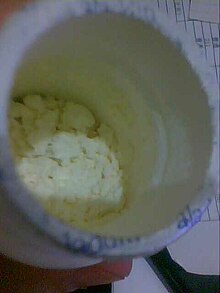Samarium(III) oxide
This article relies largely or entirely on a single source. (March 2014) |

| |
| Names | |
|---|---|
| IUPAC name
samarium(III) oxide
| |
| Other names
samarium sesquioxide, samaria
| |
| Identifiers | |
3D model (JSmol)
|
|
| ChemSpider | |
| ECHA InfoCard | 100.031.845 |
| EC Number |
|
PubChem CID
|
|
| UNII | |
CompTox Dashboard (EPA)
|
|
| |
| |
| Properties | |
| Sm2O3 | |
| Molar mass | 348.72 g/mol |
| Appearance | yellow-white crystals |
| Density | 8.347 g/cm3 |
| Melting point | 2,335 °C (4,235 °F; 2,608 K) |
| Boiling point | Not Stated |
| insoluble | |
| +1988.0·10−6 cm3/mol | |
| Structure | |
| Cubic, cI80 | |
| Ia-3, No. 206 | |
| Hazards | |
| GHS labelling: | |
 
| |
| Warning | |
| H319, H410 | |
| P264, P273, P280, P305+P351+P338, P337+P313, P391, P501 | |
| Related compounds | |
Other anions
|
Samarium(III) chloride |
Other cations
|
Promethium(III) oxide, Europium(III) oxide |
Except where otherwise noted, data are given for materials in their standard state (at 25 °C [77 °F], 100 kPa).
| |
Samarium(III) oxide (Sm2O3) is a chemical compound. Samarium oxide readily forms on the surface of samarium metal under humid conditions or temperatures in excess of 150°C in dry air. Similar to rust on metallic iron, this oxide layer spalls off the surface of the metal, exposing more metal to continue the reaction. The oxide is commonly white to off yellow in color and is often encountered as a highly fine dust like powder.
Uses
[edit]Samarium(III) oxide is used in optical and infrared absorbing glass to absorb infrared radiation. Also, it is used as a neutron absorber in control rods for nuclear power reactors. The oxide catalyzes the dehydration and dehydrogenation of primary and secondary alcohols.[1] Another use involves preparation of other samarium salts.[2]
Preparations
[edit]Samarium(III) oxide may be prepared by two methods:
1. thermal decomposition of samarium(III) carbonate, hydroxide, nitrate, oxalate or sulfate:
- Sm2(CO3)3 → Sm2O3 + 3 CO2
2. by burning the metal in air or oxygen at a temperature above 150 °C:
- 4 Sm + 3 O2 → 2 Sm2O3
Reactions
[edit]Samarium(III) oxide dissolves in mineral acids, forming salts upon evaporation and crystallization:
- Sm2O3 + 6 HCl → 2 SmCl3 + 3 H2O
The oxide can be reduced to metallic samarium by heating with a reducing agent, such as hydrogen or carbon monoxide, at elevated temperatures.
References
[edit]- ^ Catalytic properties of samarium oxide with respect to the dehydrogenation and dehydration of alcohols and the dehydrogenation of tetralin. Bulletin of the Academy of Sciences of the USSR, Division of chemical science, January 1964, Volume 13, Issue 1, pp 6–9.
- ^ Pradyot Patnaik. Handbook of Inorganic Chemicals. McGraw-Hill, 2002, ISBN 0-07-049439-8
